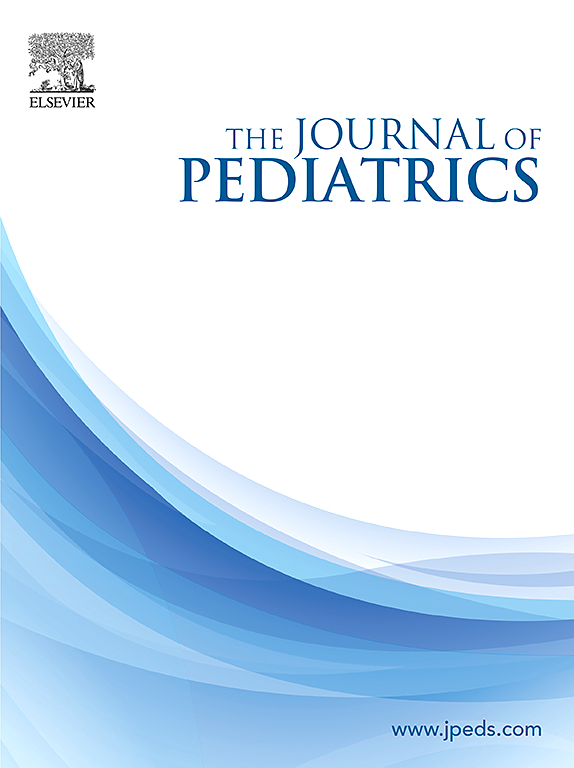Gestational Diabetes Mellitus and School-Age Cognitive and Health Outcomes in New Zealand: A Matched Cohort Study
IF 3.5
2区 医学
Q1 PEDIATRICS
引用次数: 0
Abstract
Objective
To determine if children exposed in utero to gestational diabetes mellitus (GDM) have poorer school-age neurocognitive and cardiometabolic function than matched children not exposed to GDM.
Study design
In a matched, cohort study, we compared 186 children of women diagnosed with GDM from a trial cohort with 186 children born at the same hospital whose mothers did not have GDM, matched for child sex, maternal body mass index (BMI), ethnicity, socio-economic status, and gestational age. Both GDM-exposed and nonGDM-exposed children were assessed at 6-7 years’ corrected age for neurocognitive function (NIH Toolbox), numeracy (Checkout Game), body composition, and peripheral/central blood pressure. The primary outcome was the Composite Cognitive Standard Score. Analysis was by generalized linear models, adjusted for matching criteria; exposure effects were estimated as OR or mean difference (MD), with 95% confidence intervals.
Results
Exposure groups were similar for birthweight z-score, corrected age at assessment, matching criteria, and hypertensive disorders of pregnancy. There was no difference between groups in mean cognitive score (104[15] vs 104[15]; MD = 2[−2, 5]) or its components. GDM-exposed children were less likely to have motor impairment (6% vs 11%, aRD = −6[−11, −1] but more likely to have low numeracy (10% vs 4%, aRD = 6[2, 11]) and hypertension (14% vs 6%, aRD = 8[1, 14]), and had higher mean BMI z-scores (0.95[1.61] vs 0.51[1.50], MD = 0.39[0.13, 0.65]).
Conclusions
Children exposed to GDM are not at increased risk of poorer school-age cognitive function compared with controls matched for potential confounders. However, GDM exposure was associated with increased childhood BMI and hypertension, which may affect subsequent cardiometabolic health.
新西兰妊娠期糖尿病与学龄认知和健康结局:一项匹配队列研究
目的:确定在子宫内暴露于妊娠期糖尿病(GDM)的儿童是否比未暴露于GDM的匹配儿童具有更差的学龄神经认知和心脏代谢功能。研究设计:在一项匹配的队列研究中,我们比较了186名被诊断为GDM的妇女的孩子和186名在同一医院出生的母亲没有GDM的孩子,匹配了儿童性别、母亲体重指数(BMI)、种族、社会经济地位和胎龄。在校正年龄6-7岁时,对gdm暴露和非ongdm暴露的儿童进行神经认知功能(NIH工具箱)、计算能力(Checkout Game)、身体成分和外周/中枢血压的评估。主要结果是综合认知标准评分。采用广义线性模型进行分析,并根据匹配标准进行调整;暴露效应以比值比(OR)或平均差(MD)估计,置信区间为95%。结果:暴露组在出生体重z分数、校正评估年龄、匹配标准和妊娠高血压疾病方面相似。两组之间的平均[SD]认知评分无差异(104[15]vs 104[15];MD=2[-2,5])或其分量。gdm暴露儿童发生运动障碍的可能性较低(6%对11%,aRD=-6[-11,-1]),但更容易出现计算能力低下(10%对4%,aRD=6[2,11])和高血压(14%对6%,aRD=8[1,14]),且BMI z-score均值较高(0.95[1.61]对0.51 [1.50],MD= 0.39[0.13, 0.65])。结论:与潜在混杂因素相匹配的对照组相比,暴露于GDM的儿童学龄认知功能较差的风险并未增加。然而,GDM暴露与儿童BMI增加和高血压有关,这可能影响随后的心脏代谢健康。
本文章由计算机程序翻译,如有差异,请以英文原文为准。
求助全文
约1分钟内获得全文
求助全文
来源期刊

Journal of Pediatrics
医学-小儿科
CiteScore
6.00
自引率
2.00%
发文量
696
审稿时长
31 days
期刊介绍:
The Journal of Pediatrics is an international peer-reviewed journal that advances pediatric research and serves as a practical guide for pediatricians who manage health and diagnose and treat disorders in infants, children, and adolescents. The Journal publishes original work based on standards of excellence and expert review. The Journal seeks to publish high quality original articles that are immediately applicable to practice (basic science, translational research, evidence-based medicine), brief clinical and laboratory case reports, medical progress, expert commentary, grand rounds, insightful editorials, “classic” physical examinations, and novel insights into clinical and academic pediatric medicine related to every aspect of child health. Published monthly since 1932, The Journal of Pediatrics continues to promote the latest developments in pediatric medicine, child health, policy, and advocacy.
Topics covered in The Journal of Pediatrics include, but are not limited to:
General Pediatrics
Pediatric Subspecialties
Adolescent Medicine
Allergy and Immunology
Cardiology
Critical Care Medicine
Developmental-Behavioral Medicine
Endocrinology
Gastroenterology
Hematology-Oncology
Infectious Diseases
Neonatal-Perinatal Medicine
Nephrology
Neurology
Emergency Medicine
Pulmonology
Rheumatology
Genetics
Ethics
Health Service Research
Pediatric Hospitalist Medicine.
 求助内容:
求助内容: 应助结果提醒方式:
应助结果提醒方式:


